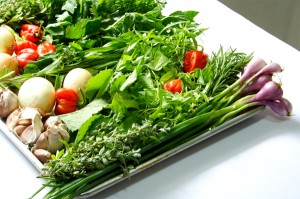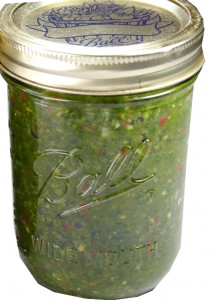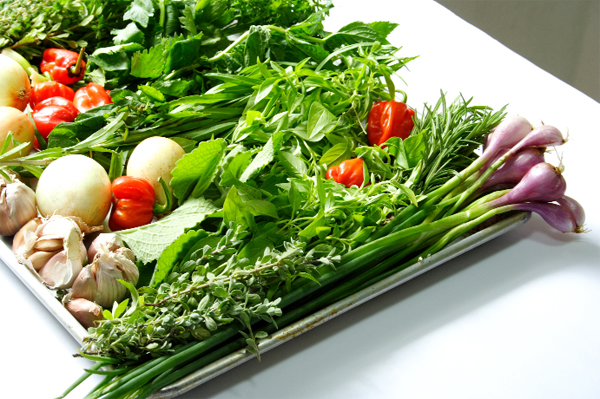Green seasoning
A must-have in many kitchens
Hi Everyone, It is that certain something that makes you go ‘ummm’ as you eat, it’s that mysterious flavour that makes certain dishes uniquely delicious, and it is that special seasoning that defines certain cuisines.

For the Italians it’s soffritto, for the French mirepoix, for the Spanish-speaking Caribbean, sofrito; many cuisines have their own versions of the holy trinity (green peppers, onions and celery) and we in the English-speaking Caribbean have green seasoning. The soffritto, mirepoix, sofrito, holy trinity and green seasoning are all versatile flavour-bases made with a combination of herbs and aromatics. They are used in various cuisines to give that unique flavour and taste to certain dishes. The Italian soffritto is generally made by sautéing chopped onions with garlic in olive oil to which can be added one or more of the following: olives, carrots, celery, etc. The French mirepoix is celery, onions and carrots sautéed in butter or oil; the Latin American sofrito is a blended mixture of tomatoes, roasted peppers, garlic, onions, herbs, especially culantro (more commonly known, especially in Trinidad & Tobago, as chadon beni). The holy trinity varies depending on the cuisine, but the one we hear of most often is the Cajun and Creole cuisine-inspired one of Louisiana in the United States of America – celery, onions and bell peppers sautéed in oil and butter. Our green seasoning is more closely aligned with Latin American sofrito in that it is not a cooked sauce and it can be used to season foods before they are ready to be cooked; the ingredients are blended and stored in the refrigerator or freezer until ready for use. Each household, I believe, has its own combination of ingredients that make up the very herby green seasoning.

At home when I was growing up we made our own green seasoning with the following combination: onions, garlic, hot peppers, green onions, thyme, celery and basil. Today, my green seasoning has all of the above plus rosemary, tarragon, parsley, mint, marjoram and cilantro, simply because they are readily available here at the markets in Barbados.
Green seasoning is a must-have in many kitchens and some people cannot imagine cooking without it. I know of people who load up on homemade and store-bought bottles of green seasoning to take back with them abroad. It’s great for marinating chicken, meat or fish, in preparation for baking, grilling, roasting or frying. It is used as a base to sauté vegetables. It makes quick work of putting together a curry paste by simply adding the ground garam masala and turmeric or curry powder to it. It is also an excellent base for stews and sauces.
When my best friend was away studying I made a bottle of green seasoning for her to take back to America. She said that for her it was like gold as it was really a great way to get a taste of home. Actually, whenever I get an email from a reader saying that they want the recipe for Guyanese or Caribbean baked chicken, fried fish or stew, I know immediately what it is that they are referring to, that unique and homey taste that the green seasoning imparts to such dishes.
Making your own green seasoning is easy. Start by choosing a combination of herbs that you like. There are certain herbs that some people cannot tolerate or do not like at all, such as celery or cilantro. Then there are some herbs that are stronger in flavour than others, and putting too much of those into your green seasoning can overpower the other ingredients, so you need to bear that in mind. What you are looking for is to strike a balance. You certainly do not have to put all the herbs I’ve listed into your green seasoning:
green onions, thyme, celery, rosemary, tarragon, parsley, mint, marjoram, cilantro, and basil. I’d recommend thyme, marjoram, basil, parsley, celery. In my green seasoning, I tend to put more green onions, celery and thyme – herbs I would use more often in my everyday cooking. Use the herbs you like or the ones available in your market. Onions and garlic are a must along with hot peppers. I use Scotch Bonnet. You can make your green seasoning as hot or as mild as you like.
Start by washing and cleaning all your ingredients, pat them dry and then chop them up roughly and in large pieces. Remember they are going to be ground up so there’s no need for perfect dicing or slicing. I usually quarter my onions depending on their size, the garlic cloves I leave whole as well as the peppers. The only thing I really cut up is the green onions, everything else comes on a stem and can easily be torn or pulled off.
Once that is done, fill the bowl of your food processor with the ingredients and sprinkle some salt – the salt works as a preservative – close the lid and let the food processor run until everything is reduced to a puree or very fine mince. Be sure to scrape down the sides of the bowl. Transfer the mixture to a large bowl and repeat until all the ingredients have been ground up.
Fill clean glass jars with the green seasoning, close tightly and store in the refrigerator. Each time you open a jar to get some of the seasoning be sure to use a clean utensil to avoid spoilage. The green seasoning lasts for a very long time; it may lose some of the bright green colour but the flavour will remain. If you’re into freezing your green seasoning, do so in ice trays and store the cubes in zip bags and defrost when ready to use.
If you’ve never made and used green seasoning before, try it, and use it to make a dish in which it will really shine through – like baked chicken or some kind of meat or as the base in a stew of meat, vegetables or legumes. Be sure to invite guests; I bet they’ll be wondering what it is that you put in the food to make it so tasty. Don’t worry, I won’t tell them what your secret ingredient is; it’ll be our little secret.
Cynthia
www.tasteslikehome.org

